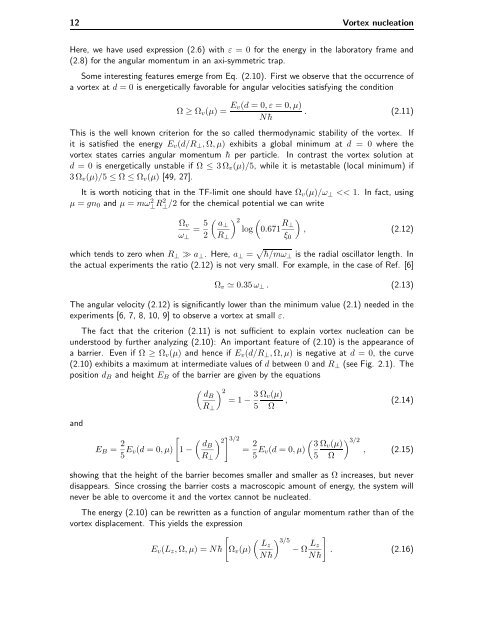- Page 1: Università degli Studi di Trento F
- Page 4: 7 Bogoliubov excitations of Bloch s
- Page 9 and 10: Chapter 1 Introduction Superfluids
- Page 11 and 12: The second class of stationary solu
- Page 13 and 14: Chapter 2 Vortex nucleation The pro
- Page 15: 2.1 Single vortex line configuratio
- Page 19 and 20: 2.2 Role of Quadrupole deformations
- Page 21 and 22: 2.3 Critical angular velocity for v
- Page 23 and 24: 2.3 Critical angular velocity for v
- Page 25: 2.4 Stability of a vortex-configura
- Page 29 and 30: Chapter 3 Introduction Since the ac
- Page 31 and 32: The order parameter’s temporal ev
- Page 33 and 34: and spectroscopy were described in
- Page 35 and 36: the external probe generates a dens
- Page 37 and 38: Chapter 4 Single particle in a peri
- Page 39 and 40: 4.1 Solution of the Schrödinger eq
- Page 41 and 42: 4.1 Solution of the Schrödinger eq
- Page 43 and 44: 4.1 Solution of the Schrödinger eq
- Page 45 and 46: 4.1 Solution of the Schrödinger eq
- Page 47 and 48: 4.2 Tight binding regime 43 describ
- Page 49 and 50: 4.2 Tight binding regime 45 paramet
- Page 51 and 52: Chapter 5 Groundstate of a BEC in a
- Page 53 and 54: 5.1 Density profile, energy and che
- Page 55 and 56: 5.1 Density profile, energy and che
- Page 57 and 58: 5.2 Compressibility and effective c
- Page 59 and 60: 5.4 Effects of harmonic trapping 55
- Page 61 and 62: 5.4 Effects of harmonic trapping 57
- Page 63 and 64: 5.4 Effects of harmonic trapping 59
- Page 65 and 66: 5.4 Effects of harmonic trapping 61
- Page 67 and 68:
Chapter 6 Stationary states of a BE
- Page 69 and 70:
6.1 Bloch states and Bloch bands 65
- Page 71 and 72:
6.1 Bloch states and Bloch bands 67
- Page 73 and 74:
6.1 Bloch states and Bloch bands 69
- Page 75 and 76:
6.1 Bloch states and Bloch bands 71
- Page 77 and 78:
6.1 Bloch states and Bloch bands 73
- Page 79 and 80:
6.2 Tight binding regime 75 conside
- Page 81 and 82:
6.2 Tight binding regime 77 Compari
- Page 83 and 84:
6.2 Tight binding regime 79 2m¯v/q
- Page 85 and 86:
6.2 Tight binding regime 81 The lea
- Page 87 and 88:
Chapter 7 Bogoliubov excitations of
- Page 89 and 90:
7.2 Bogoliubov bands and Bogoliubov
- Page 91 and 92:
7.2 Bogoliubov bands and Bogoliubov
- Page 93 and 94:
7.2 Bogoliubov bands and Bogoliubov
- Page 95 and 96:
7.2 Bogoliubov bands and Bogoliubov
- Page 97 and 98:
7.3 Tight binding regime of the low
- Page 99 and 100:
7.3 Tight binding regime of the low
- Page 101 and 102:
7.4 Velocity of sound 97 d|bjql| 2
- Page 103 and 104:
7.4 Velocity of sound 99 c(s)/c(s=0
- Page 105 and 106:
Chapter 8 Linear response - Probing
- Page 107 and 108:
8.1 Dynamic structure factor 103 wi
- Page 109 and 110:
8.1 Dynamic structure factor 105 Th
- Page 111 and 112:
8.1 Dynamic structure factor 107 Th
- Page 113 and 114:
8.2 Static structure factor and sum
- Page 115 and 116:
8.2 Static structure factor and sum
- Page 117 and 118:
8.2 Static structure factor and sum
- Page 119 and 120:
Chapter 9 Macroscopic Dynamics In t
- Page 121 and 122:
9.1 Macroscopic density and macrosc
- Page 123 and 124:
9.2 Hydrodynamic equations for smal
- Page 125 and 126:
9.4 Sound Waves 121 9.4 Sound Waves
- Page 127 and 128:
9.5 Small amplitude collective osci
- Page 129 and 130:
9.5 Small amplitude collective osci
- Page 131 and 132:
9.5 Small amplitude collective osci
- Page 133 and 134:
9.6 Center-of-mass motion: Linear a
- Page 135 and 136:
9.6 Center-of-mass motion: Linear a
- Page 137 and 138:
Chapter 10 Array of Josephson junct
- Page 139 and 140:
10.1 Current-phase dynamics in the
- Page 141 and 142:
10.2 Lowest Bogoliubov band 137 µ
- Page 143 and 144:
10.3 Josephson Hamiltonian 139 wher
- Page 145 and 146:
10.3 Josephson Hamiltonian 141 For
- Page 147 and 148:
Chapter 11 Sound propagation in pre
- Page 149 and 150:
11.2 Current-Phase dynamics 145 [14
- Page 151 and 152:
11.3 Nonlinear propagation of sound
- Page 153 and 154:
n(x, t)/n(x, t=0) 11.3 Nonlinear pr
- Page 155 and 156:
11.3 Nonlinear propagation of sound
- Page 157 and 158:
11.3 Nonlinear propagation of sound
- Page 159 and 160:
∆ n ( U / δ ) 1/2 1 0.8 0.6 0.4
- Page 161 and 162:
11.4 Experimental observability 157
- Page 163 and 164:
Chapter 12 Condensate fraction The
- Page 165 and 166:
12.2 Uniform case 161 The Bogoliubo
- Page 167 and 168:
12.2 Uniform case 163 The solution
- Page 169 and 170:
12.3 Shallow lattice 165 12.3 Shall
- Page 171 and 172:
12.4 Tight binding regime 167 3D th
- Page 173 and 174:
12.4 Tight binding regime 169 direc
- Page 175 and 176:
12.4 Tight binding regime 171 Quant
- Page 179 and 180:
Bibliography [1] L. Pitaevskii and
- Page 181 and 182:
[31] E. Lundh, C.J. Pethick, and H.
- Page 183 and 184:
[63] B.P. Anderson, P.C. Haljan, C.
- Page 185 and 186:
[91] T. Stöferle, H. Moritz, C. Sc
- Page 187 and 188:
[125] E. Taylor and E. Zaremba, Bog
- Page 189:
[157] R.M. Bradley and S. Doniach,




